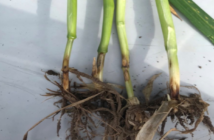UPL is committed to ensuring the long-term future of Centurion Max through effective stewardship, product development and resistance monitoring.
As the sugar beet drilling season gets underway, many growers will turn to Centurion Max (clethodim) to overcome grassweed challenges. But its benefits for grassweed control extend far further than a single crop and have positive ramifications across the whole arable rotation.
“Centurion Max remains an integral part of the growers’ overall grassweed management strategy, providing an effective alternative mode of action in the grassweed battle,” says head of technical services at UPL, Stuart Jackson. “And importantly, it is effective across a wide range of crops typically grown in an arable rotation i.e. oilseed rape and sugar beet (on label) and linseed, vining peas, and fodder beet, via Extension of Authorisation for Minor Use (EAMU).”
Clethodim remains highly effective at controlling blackgrass and ryegrass, which differentiates it from other DIM herbicides such as cycloxydim, which have blackgrass resistance issues, says Stuart. “UPL is committed to maintaining clethodim’s efficacy and while blackgrass resistance has been seen in the active, it is not advancing.”
The company keeps an eye on grassweed resistance to clethodim through an ongoing monitoring programme carried out by consultant, Dr Stephen Moss.
Stephen says: “With the commonest blackgrass ACCase mutation (1781), clethodim still gives good control whereas cyloxydim gives very poor control.
“With ryegrass the picture is less clear as a different ACCase mutation (2078) is commonest in the UK and this has been shown to confer some resistance in other grassweeds in other countries. We are currently working on this to get more of a handle on what happens in UK ryegrass populations – control may depend on what mutation is present in the individual field, which will justify more specific testing. We should have the results soon.
“To get the most out of clethodim you need to know what you’re dealing with. Stewardship will be important to maintaining its efficacy over the next 10 years. There needs to be a genuine desire to keep it working by not using it too often. UPL recognises this.”
Clethodim’s efficacy can also be boosted by using an acidic water conditioner, says Stephen. “In earlier trials we did for Affinity Water we found the herbicide worked well, giving 80% control, regardless of water hardness. But the addition of acidic water conditioner, X-Change consistently improved the performance of clethodim, regardless of water hardness, increasing it to 90% control.”
UPL puts a high emphasis on stewardship, carrying out field trials which enable it to inform growers on how to get the best from the product. “This includes application timing, application technique and use of a water conditioner,” says Stuart. “Also, spray intervals between previous crop protection products and clethodim should be managed to ensure optimum weed control and minimise risk from potential crop injury / phytotoxicity with other crop protection products, especially if these products have caused injury to the crop before the clethodim is applied.”
Sugar beet
Looking at sugar beet, drilled at the end of March/early April, it initially receives ethofumesate as part of the broadleaf weed strategy – it also has some beneficial activity on grassweeds. “This is followed up with Centurion Max when blackgrass is at the three-leaf stage,” says Stuart.
Key advice for using Centurion Max on sugar beet includes:
>Use a water conditioner to improve efficacy in hard water areas
>Do not mix with adjuvants (Centurion Max has a built-in adjuvant)
>Applications must be made to actively growing weeds
>Five-day no spray period for any herbicide before clethodim application
>14-day no spray period for herbicides post-clethodim application
>Do not apply in cold weather
Best practice
>Apply at 1l/ha in a minimum of 200L of water to ensure good uptake
>Use drift reducing nozzles and apply in best spraying conditions, with a suitable forward speed to ensure good coverage
>Ensure blackgrass has reached three leaves and is actively growing. Best coverage of weeds is required for optimum efficacy
>Minimise spray overlap to reduce risk of crop damage.
Oilseed rape
Centurion Max is also a key part of managing weeds in oilseed rape, with the herbicide applied in early October and followed up with propyzamide 4-6 weeks later. Some operators apply them in a single tank mix for convenience, in early October, says Stuart.
Other key advice for using Centurion Max in oilseed rape includes:
> Do not mix with propyzamide AND an insecticide
> Do not apply after 15 October or six-leaf stage of the crop, whichever comes first
> No spring applications
> 10-day no spray period before clethodim
> 14-day no spray period after clethodim for other plant protection products
> After seven days, application of nutritional products and insecticides permissible
>Ensure there is no crop stress or pest damage
>Adequate crop waxing and crop nutrition will also minimise risk.
Best practice in oilseed rape
(See best practice section for sugar beet) plus:
>For effective resistance management, use tank mixes or sequences of effective herbicides with different modes of action such as propyzamide.
Recent research on grassweeds in oilseed rape shows that Centurion Max/propyzamide tank mixes control ryegrass to the same extent as sequences, but with blackgrass, sequential spraying is better.
Product development
UPL continues to work on product development, says Stuart. “We are looking at use in alternative crops. This could be via support to growers looking for use in an EAMU via grower groups. We can give access to our product data bases and dossier to help with this.
“We are also looking and where we can extend our labelled crops range, for example to pulses.”
Alternative MoA
Clethodim has a different MoA to ALS herbicides and as such bolsters grassweed control in break-crops, meaning less pressure on ALS herbicides in the following cereal crops. This is a key part of an effective grassweed management strategy.




